
Glendale Centre Theatre presents West Side Story as you may never have seen it before–up close and in the round. Terrific lead and supporting performances guarantee GCT yet another hit, and whenever the production’s top-drawer dance ensemble launch into one of Jerome Robbins’s iconic dance numbers as adapted by Orlando Alexander, the show takes particularly high flight.
Not that arena staging doesn’t have its drawbacks. Minus proscenium sets, it’s harder to feel immersed in the 1957 Broadway classic’s mix of urban oppressiveness and grit, particularly when there are audience members in view no matter which way you look, but co-directors Danny Michaels and Alexander know how to both grip and entertain an audience with this Romeo And Juliet update moved to the mid-‘50s mean streets of New York.
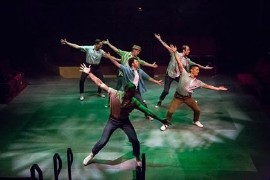 With jazz-and-opera-inspired music by Leonard Bernstein, poetic lyrics by Stephen Sondheim, and R-&-J-inspired book by Arthur Laurents, West Side Story may seem tame compared to the gang warfare flashed on today’s TV screens, but its tragic tale of star-crossed lovers remains as potent as ever in 2018.
With jazz-and-opera-inspired music by Leonard Bernstein, poetic lyrics by Stephen Sondheim, and R-&-J-inspired book by Arthur Laurents, West Side Story may seem tame compared to the gang warfare flashed on today’s TV screens, but its tragic tale of star-crossed lovers remains as potent as ever in 2018.
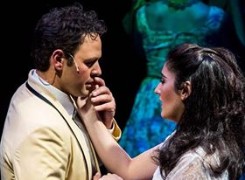 Only a heart of stone could fail to be moved by the love which ignites between born-in-the-USA Tony and recent Puerto Rican émigré Maria one fateful night at a high school gymnasium—only to be extinguished just a day later on the West Side streets of Manhattan.
Only a heart of stone could fail to be moved by the love which ignites between born-in-the-USA Tony and recent Puerto Rican émigré Maria one fateful night at a high school gymnasium—only to be extinguished just a day later on the West Side streets of Manhattan.
The best reason to catch WSS at GCT is the chance to experience moves originally designed to be seen through a theatrical fourth wall reimagined to reach across all four, with Jets and Sharks leaping across the stage in choreography so seamless it’s hard to tell where real life street fights end and dancing begins.
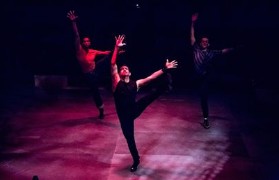 Not only do rival gangs do their dances of menace and death this way and that … and that … and that, the mambo beats of “Dance At The Gym,” the Latin foot stomps of “America,” and the balletic moves of the Act 2 dream sequence remain as thrilling today as they did in ’57.
Not only do rival gangs do their dances of menace and death this way and that … and that … and that, the mambo beats of “Dance At The Gym,” the Latin foot stomps of “America,” and the balletic moves of the Act 2 dream sequence remain as thrilling today as they did in ’57.
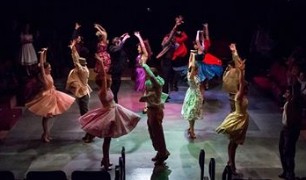 It helps enormously that choreographer Alexander finds himself blessed by an ensemble who not only ace their roles’ individual quirks under his and Michael’s assured direction but execute some of Broadway’s toughest moves with the best of them, kudos shared by Taylor Alyssa (Francisca), Danny O’Connell (A-Rab), Ashley Douglas (Rosalia), William Clayton (Diesel), Danielle Lebens (Velma), Antoine Lee (Anxious), Kathleen MacCutcheon (Graziela), Marissa Mayer (Clarice), Giovanni Navarro (Pepe), Shelley O’Rourke (Minnie), Viktor Pacheco (Toro), Roman Pantoja (Baby John), Paul Reid (Big Deal), Calista Ruiz (Consuela), Jeffrey Sabino (Indio), Cristina Santana (Estella), and (in larger roles) Bridget Pugliese (unleashing her inner tomboy as Anybodys), Sergio Salinas (a dynamic Chino), and Adam Trent (giving Action plenty of fire).
It helps enormously that choreographer Alexander finds himself blessed by an ensemble who not only ace their roles’ individual quirks under his and Michael’s assured direction but execute some of Broadway’s toughest moves with the best of them, kudos shared by Taylor Alyssa (Francisca), Danny O’Connell (A-Rab), Ashley Douglas (Rosalia), William Clayton (Diesel), Danielle Lebens (Velma), Antoine Lee (Anxious), Kathleen MacCutcheon (Graziela), Marissa Mayer (Clarice), Giovanni Navarro (Pepe), Shelley O’Rourke (Minnie), Viktor Pacheco (Toro), Roman Pantoja (Baby John), Paul Reid (Big Deal), Calista Ruiz (Consuela), Jeffrey Sabino (Indio), Cristina Santana (Estella), and (in larger roles) Bridget Pugliese (unleashing her inner tomboy as Anybodys), Sergio Salinas (a dynamic Chino), and Adam Trent (giving Action plenty of fire).
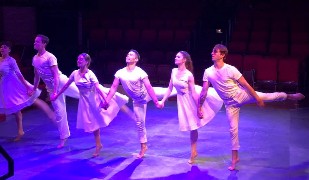 Not only that, but when injury suddenly felled two of the above at the start of the performance reviewed, the show indeed did go on with ensemble members taking on dialog, lyrics, and moves not usually theirs, in particular O’Connell’s amusing social worker in “Gee, Officer Krupke” and Lee’s graceful athleticism in “Somewhere,”.
Not only that, but when injury suddenly felled two of the above at the start of the performance reviewed, the show indeed did go on with ensemble members taking on dialog, lyrics, and moves not usually theirs, in particular O’Connell’s amusing social worker in “Gee, Officer Krupke” and Lee’s graceful athleticism in “Somewhere,”.
Chanlon Kaufman and Ani Marderosian make for a captivating pair of starcrossed young lovers, the former’s tenor soaring in “Something’s Coming” and “Maria,” the latter’s acting chops making Maria far more than innocent young thing and never more so than in the character’s final, devastating moments.
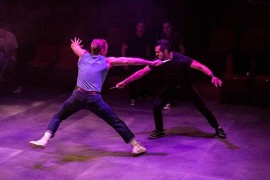 John Paul Batista and Ethan Daniel Corbett burn up the stage as rival gang leaders Bernardo and Riff, and speaking of fire, best-of-show goes to Linda Neel, whose scorcher of an Anita thrills and devastates in equal measure, most notably in a gut-wrenching “A Boy Like That.”
John Paul Batista and Ethan Daniel Corbett burn up the stage as rival gang leaders Bernardo and Riff, and speaking of fire, best-of-show goes to Linda Neel, whose scorcher of an Anita thrills and devastates in equal measure, most notably in a gut-wrenching “A Boy Like That.”
Douglas and Wayne Remington (Diesel) duet a lovely “Somewhere,” dance captain Kevin Holmquist is quintessentially Krupke-esque, Kyle Kelley’s Doc provides a just-right mix of paternal warmth and frustration, and you’d never guess it was the same Ted Wells playing both the weirdly geeky Glad-Hand and the casually racist Shrank.
 Lori Lee Jacobson scores top marks for her character-defining period costumes, muted hues for Sharks, deeper, more vibrant ones for Jets, and they look even better under Jeremy Williams’s drama-enhancing lighting design. Michaels’ scenic design transforms the stage from urban street to bridal shop to Doc’s drug store. Kudos too to Robert Glen Decker’s properties design.
Lori Lee Jacobson scores top marks for her character-defining period costumes, muted hues for Sharks, deeper, more vibrant ones for Jets, and they look even better under Jeremy Williams’s drama-enhancing lighting design. Michaels’ scenic design transforms the stage from urban street to bridal shop to Doc’s drug store. Kudos too to Robert Glen Decker’s properties design.
Musical director Steven Applegate guarantees topnotch cast vocalizing, though West Side Story is the rare instance where Glendale Centre Theatre’s prerecorded tracks are no substitute for a full, symphonic orchestra, and GCT’s sound system does no favors to a soprano’s high notes. Trey Douglas is sound designer.
West Side Story is produced by Brenda Dietlein. Kristin Bolinski is stage manager.
West Side Story may be set sixty years in the past, but there hasn’t been nearly enough progress in race relations to make it less powerful today than at its Broadway debut. Glendale Centre Theatre’s in-the-round revival may not match big-budget proscenium stagings, but it offers audience more than enough reason to revisit this timeless classic.
Glendale Centre Theatre, 324 N. Orange St., Glendale.
www.GlendaleCentreTheatre.com
–Steven Stanley
April 26, 2018
Photos by Rock With You Photography except photos 5 and 7 by Jeremy Williams
Tags: Arthur Laurents, Glendale Centre Theatre, Jerome Robbins, Leonard Bernstein, Los Angeles Theater Review, Stephen Sondheim



 Since 2007, Steven Stanley's StageSceneLA.com has spotlighted the best in Southern California theater via reviews, interviews, and its annual StageSceneLA Scenies.
Since 2007, Steven Stanley's StageSceneLA.com has spotlighted the best in Southern California theater via reviews, interviews, and its annual StageSceneLA Scenies.







 COPYRIGHT 2025 STEVEN STANLEY :: DESIGN BY
COPYRIGHT 2025 STEVEN STANLEY :: DESIGN BY